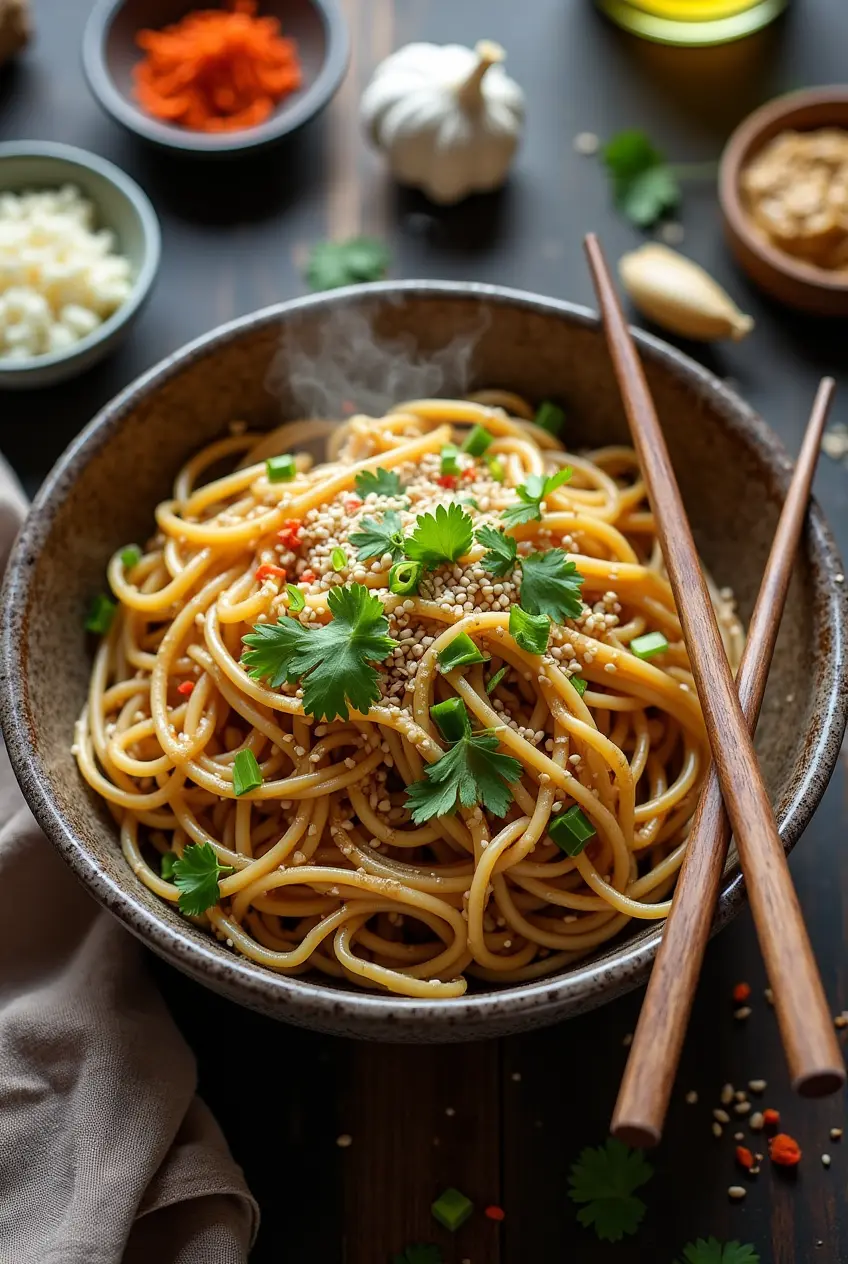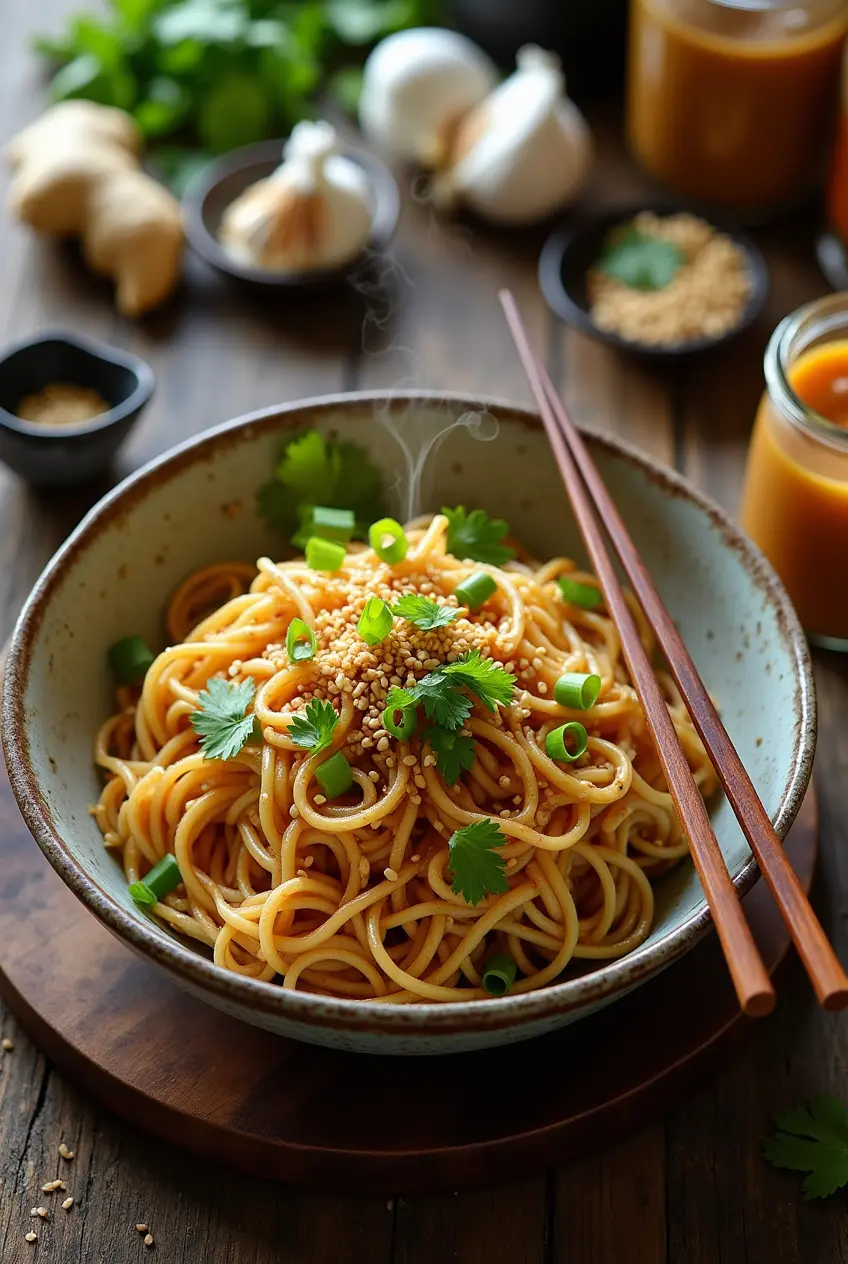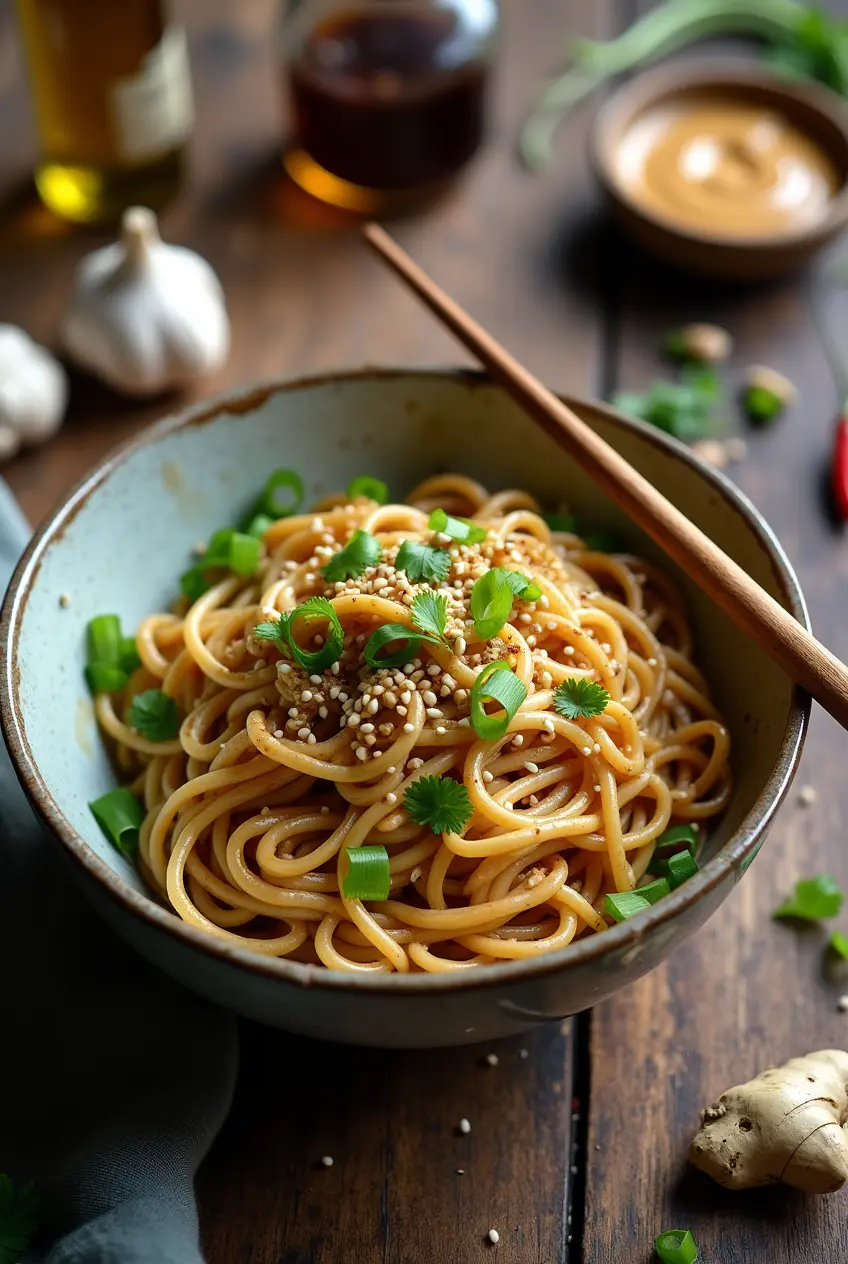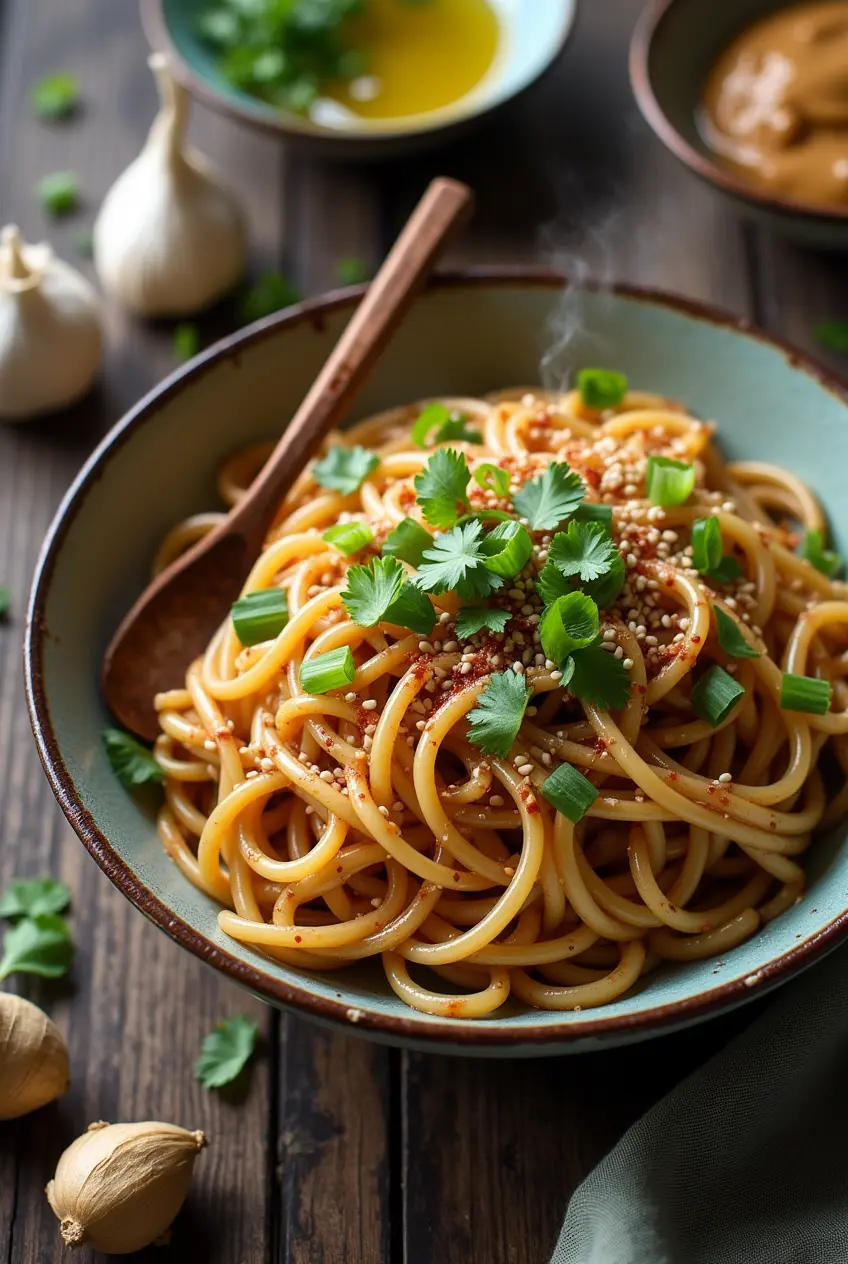ADVERTISEMENT
How to Make Sesame Noodles in Under 20 Minutes
Introduction: The Quick Noodle Revolution
Did you know that the average American spends 37 minutes preparing dinner each night, yet 43% of us claim we don’t have enough time to cook at home? What if you could create a restaurant-quality dish in half that time? Sesame noodles, a beloved dish with roots in Sichuan cuisine, offers exactly that promise – a quick, versatile meal that delivers complex flavors without complex preparation.
These deliciously nutty noodles have existed across multiple cultures for thousands of years, evolving into countless regional variations. Today, I’m sharing my perfected sesame noodles recipe that comes together in less than 20 minutes, making it perfect for busy weeknights when you crave something satisfying but don’t want to resort to takeout.

ADVERTISEMENT
Ingredients List
For the noodles:
- 8 oz Chinese egg noodles (yangchun) or spaghetti/linguine as an alternative
- 1 medium carrot, julienned
- ½ medium cucumber, seeded and julienned
- 3 scallions, thinly sliced
- 1 tablespoon toasted sesame seeds
For the sauce:
- 3 tablespoons Chinese sesame paste (or substitute with natural peanut butter plus 1 teaspoon sesame oil)
- 2 tablespoons low-sodium soy sauce
- 1 tablespoon rice vinegar
- 1 tablespoon honey (or maple syrup for vegan option)
- 1 teaspoon freshly grated ginger
- 2 cloves garlic, minced
- 1 tablespoon chili oil (optional, for heat)
- 2-4 tablespoons warm water to thin the sauce
The aromatic combination of toasted sesame, ginger, and garlic creates a symphony of flavors that will tantalize your senses, while the crisp vegetables add refreshing texture contrast to the silky noodles.
Timing
- Preparation time: 10 minutes
- Cooking time: 8 minutes
- Total time: 18 minutes
This recipe takes 52% less time than the average home-cooked dinner, making it an efficient option for time-conscious cooks. The minimal cooking involved (just boiling noodles) also means less time spent managing multiple pots and pans, and less cleanup afterward.
Step-by-Step Instructions
Step 1: Prepare Your Ingredients
Before you begin cooking, julienne your vegetables and prepare your aromatics. Having everything mise en place (prepared and ready) is especially important for quick-cooking recipes like sesame noodles. Pro tip: Use a vegetable peeler to create beautiful, thin ribbons of carrot and cucumber for a more elegant presentation.
Step 2: Boil the Noodles
Bring a large pot of water to a boil over high heat. Add your noodles and cook according to package instructions, typically 4-6 minutes for Chinese egg noodles. If using yangchun noodles as recommended by saveur.com, they may cook even faster. Test one noodle to ensure it’s al dente – you want a slight bite as the noodles will continue to soften in the sauce.
Step 3: Make the Sauce
While your noodles cook, whisk together all sauce ingredients except the warm water in a large bowl. The sesame paste can be quite thick, so be patient as you combine it with the other ingredients. Gradually add warm water, one tablespoon at a time, until you reach a smooth, pourable consistency that will coat the noodles evenly. Your sauce should be thick enough to cling to the noodles but thin enough to distribute easily.
Step 4: Drain and Rinse Noodles
Drain your noodles in a colander and immediately rinse with cold water to stop the cooking process and remove excess starch. This prevents clumping and gives your sesame noodles that perfect texture. Shake off excess water thoroughly – too much moisture will dilute your carefully crafted sauce.
Step 5: Toss and Serve
Add the noodles to your sauce bowl and toss until every strand is generously coated. If the sauce becomes too thick to toss easily, add another teaspoon of warm water as suggested by saveur.com. Fold in most of your julienned vegetables and sliced scallions, reserving some for garnish. Transfer to serving bowls, then top with the remaining vegetables, scallions, and a sprinkle of toasted sesame seeds.

Nutritional Information
Per serving (serves 4):
- Calories: 320
- Protein: 10g
- Carbohydrates: 42g
- Fat: 14g
- Fiber: 3g
- Sodium: 480mg
These sesame noodles provide approximately 16% of your daily protein needs and 12% of your recommended fiber intake, making them a relatively balanced quick meal option compared to many fast food alternatives that can contain up to 1,500mg of sodium per serving.
Healthier Alternatives for the Recipe
For a more nutritious spin on this classic:
- Swap regular noodles for whole wheat noodles or gluten-free alternatives like rice noodles or buckwheat soba for additional fiber and nutrients.
- Replace half the noodles with spiralized zucchini or “zoodles” to increase vegetable intake and reduce calories by approximately 20%.
- Use coconut aminos instead of soy sauce to reduce sodium content by up to 73%.
- Add edamame, tofu, or shredded chicken for additional protein, turning this side dish into a complete meal.
Research shows that incorporating whole grains can reduce the risk of heart disease by 22% compared to refined grains, making whole wheat noodles an excellent upgrade to this recipe.
Serving Suggestions
These versatile sesame noodles work beautifully as:
- A light lunch served at room temperature
- A side dish paired with grilled teriyaki salmon or chicken
- The base for a noodle bowl topped with a fried egg and extra vegetables
- A potluck contribution (the flavors actually improve after sitting for an hour)
For a complete meal, consider pairing with a simple miso soup or a side of steamed dumplings. Similar to the suggestion from joyfuldumplings.com, garnishing with additional toasted sesame seeds just before serving enhances both flavor and presentation.

Common Mistakes to Avoid
- Overcooking the noodles: They should retain a slight firmness as they’ll continue to soften in the sauce.
- Using cold sesame paste: Room-temperature paste blends much more easily. If it’s refrigerated, warm it slightly before mixing.
- Not thinning the sauce properly: According to culinary experts, the most common complaint with homemade sesame noodles is sauce that’s too thick to coat evenly. Add water gradually until you reach the right consistency.
- Skipping the noodle rinse: This crucial step prevents clumping and gives your dish that authentic restaurant texture.
- Under-seasoning: Taste and adjust before adding noodles – the flavors will become more subtle once mixed.
Storing Tips for the Recipe
Sesame noodles actually improve with a little time, making them perfect for meal prep:
- Store in an airtight container in the refrigerator for up to 3 days.
- If the noodles seem dry when refrigerated, sprinkle with a few drops of water and a teaspoon of sesame oil before reheating.
- For best results, store sauce and noodles separately if preparing more than 24 hours in advance.
- These noodles are delicious cold or at room temperature, making them ideal for packed lunches.
- Freeze portions for up to 1 month in airtight containers for quick emergency meals.
Conclusion
Sesame noodles offer that rare combination of simplicity, speed, and satisfaction that makes them perfect for today’s busy lifestyle. In less than 20 minutes, you can create a dish that’s not only delicious but also adaptable to your taste preferences and nutritional needs. The balance of nutty, savory, and slightly sweet flavors in this recipe creates a crave-worthy meal that will quickly become a staple in your cooking repertoire.
Give this sesame noodles recipe a try tonight and discover how something so quick can taste like it took hours to prepare. I’d love to hear about your experience or any creative variations you develop in the comments below!
FAQs
Can I make sesame noodles ahead of time? Absolutely! Sesame noodles often taste even better after the flavors have had time to meld. They can be made up to 24 hours in advance and stored in the refrigerator.
What’s the difference between Chinese sesame paste and tahini? Chinese sesame paste is made from toasted sesame seeds, giving it a darker color and richer flavor, while tahini is made from raw or lightly toasted seeds. In a pinch, you can substitute tahini plus a few drops of toasted sesame oil.
Are sesame noodles traditionally served hot or cold? While there are variations, sesame noodles are often served at room temperature or slightly chilled, especially in summer months, as noted by garlic-head.com.
Can I add protein to make this a complete meal? Definitely! Try adding shredded chicken, pan-seared tofu, or edamame. For a quick option similar to what tiffycooks.com suggests, top with a fried egg for added protein and a luxurious texture.
What type of noodles work best for this recipe? Traditional Chinese egg noodles (yangchun) work best, but you can also use udon, soba, or even Italian pasta like spaghetti or linguine in a pinch. Each will give a slightly different texture but still delicious results.

Author’s Top Recipe Picks
📌 10 Irresistible Puff Pastry Dessert Recipes You Need to Try
Discover the best sweet puff pastry recipes, from fruit tarts to chocolate twists!
📌 3-Ingredient Banana Oat Egg Pancakes – Healthy and Easy
A quick and nutritious breakfast that pairs perfectly with a flaky puff pastry treat!
📌 No-Bake Colorful Fruit Cake Recipe Guide
A vibrant, fuss-free dessert that’s as beautiful as it is delicious!
📌 Chocolate and Vanilla Pudding Dessert
A creamy, dreamy treat that’s sure to satisfy any sweet tooth!
📌 Air Fryer Breakfast Recipes
Quick, crispy, and delicious morning meals made easy with your air fryer!
Now, whip up these amazing recipes and enjoy every bite!
ADVERTISEMENT
